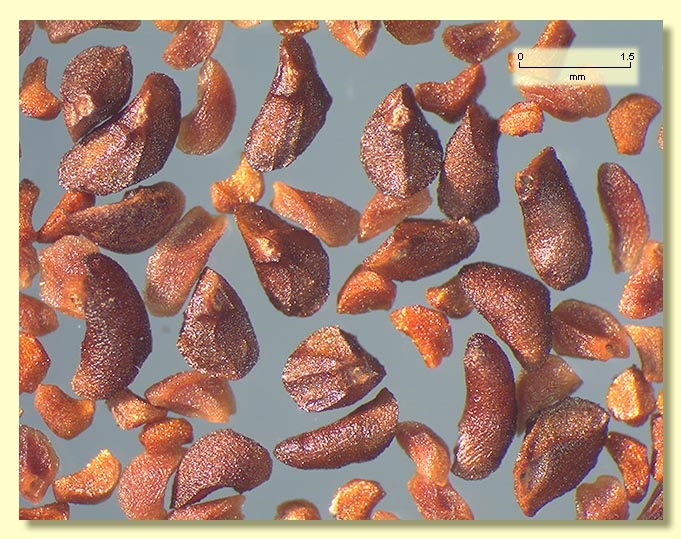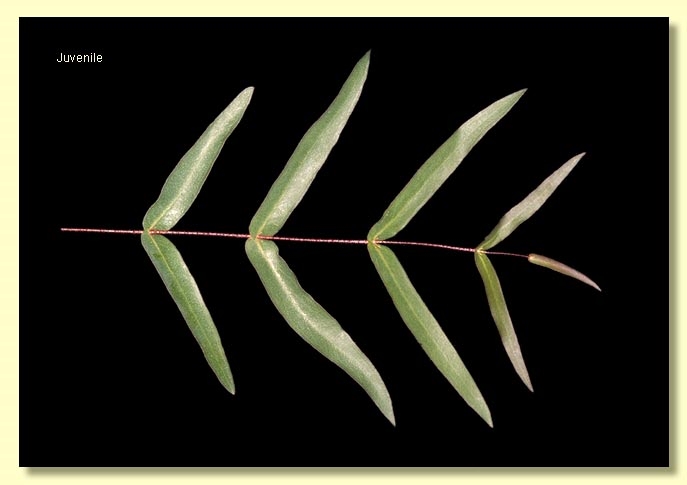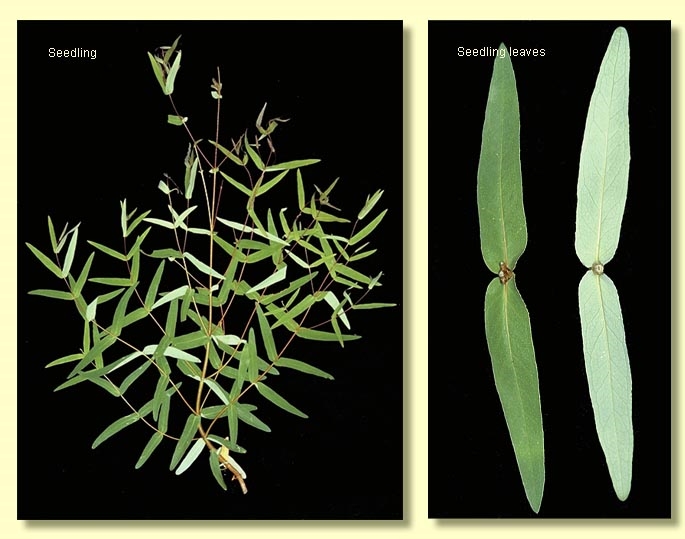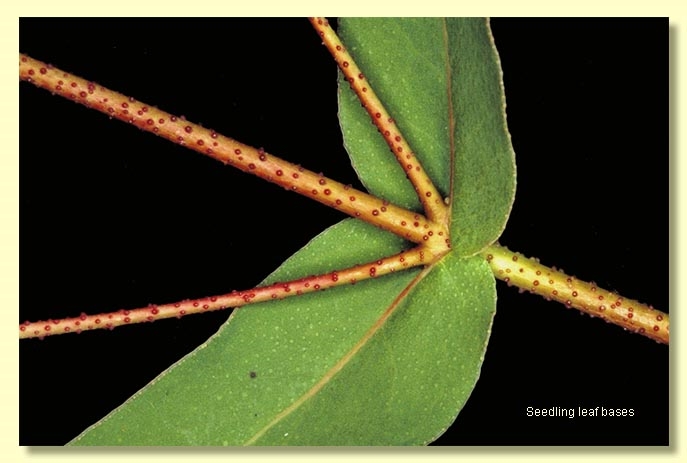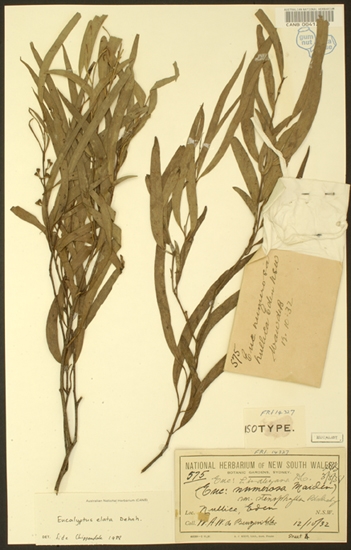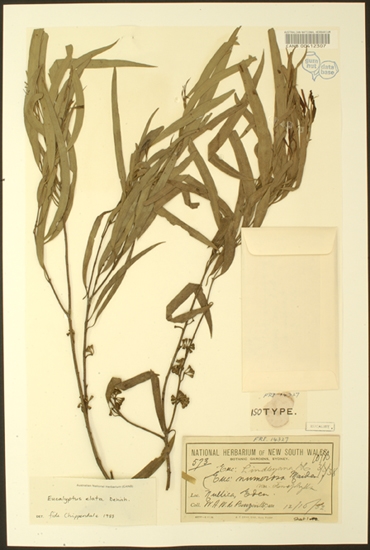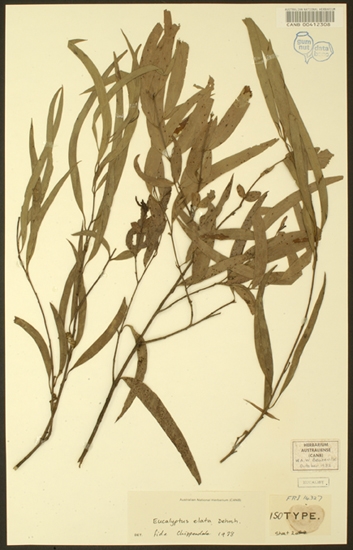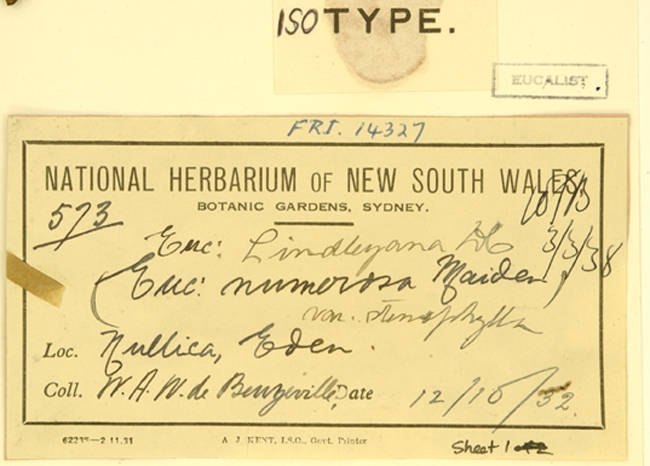Euclid - Online edition
Eucalyptus elata
Eucalyptus | Eucalyptus | Aromatica | Radiatae
Eucalyptus elata Dehnh., Cat. Plant. Hort. Camaldulensis 1: 26 (1829).
T: Italy: ex Hortus Camaldulensis, (cultivated), F.Dehnhardt s.n ., undated; lectotype: RO; isolectotype: NAP; fide Bean, A.R., Telopea 12(4): 515 (2010).
Eucalyptus amygdalina var. numerosa Maiden, Proc. Linn. Soc. New South Wales 29(4): 752 (1904, publ. 1905); A Critical Revision of the Genus Eucalyptus 1(6): 155 (1905). T: not cited; nom. illeg., as E.amygdalina var. radiata (DC.) Benth. was cited as a synonym; fide Bean, A.R., Australian Systematic Botany Society Newsletter 147-148: 10 (2011).
Eucalyptus numerosa Maiden, Proc. Linn. Soc. New South Wales 29(4): 752 (1904, publ. 1905); A Critical Revision of the Genus Eucalyptus 1(6): 155 (1905). T: not cited; nom. illeg. as E. elata Dehnh. was cited as a synonym; fide Bean, A.R., loc. cit..
Eucalyptus lindleyana var. stenophylla Blakely, Key Eucalypts 209 (1934); E. andreana var. stenophylla (Blakely) Cameron, The Victorian Naturalist 63: 41 (1946). T: Nullica, near Eden, NSW, October 1932, W.A.W.de Beuzeville s.n.; syn: NSW323478; fide Bean, A.R., loc. cit.; syn: Nullica, Eden, NSW, 12 Oct. 1932, W.A.W.de Beuzeville s.n.; CANB (3 sheets CANB412307, 412308, 412309.); [note: NSW323478: the image of this specimen clearly shows the date "9/1932" whilst the sheet CANB412307 has the date "12/10/32", whereas Bakely (ibid.) cites "October 1932"], fide A.V. Slee.
Dubious names
Eucalyptus andreana Naudin, Rev. Hort. 346 (1880). T: [cultivated specimen from gardens in France]; syntypes: P (4 sheets); nomen dubium, fide Bean, A.R., loc. cit..
Eucalyptus lindleyana DC., Prodr. 3: 219 (1828), based on E. longifolia Lindl., Bot. Reg. 11, t. 947 (1826) nom. illeg., non Link (1822). T: illustration (t. 947) in Botanical Register; nomen dubium, fide Bean, A.R., fide Bean, A.R., loc. cit..
Tree to 40 m tall, or rarely a mallee to 6 m tall. Forming a lignotuber.
In trees bark on lower trunk rough, compacted, dark grey to black, smooth above, white or cream, pale brown, green or pale grey, branches very ribbony; in mallees bark smooth throughout.
Juvenile growth (coppice or field seedlings to 50 cm): stem rounded in cross-section, warty or smooth; juvenile leaves opposite, sessile for many pairs, lanceolate to falcate, 3.3–10.5 cm long, 0.6–1.6 cm wide, bases often amplexicaul, green.
Adult leaves alternate, petiole 0.6–2 cm long; blade lanceolate to falcate, 6–22 cm long, 0.6–2 cm wide, base tapering to petiole, concolorous, glossy, green, side-veins acute to sub-parallel, sparsely reticulate, intramarginal vein parallel to and well removed from margin (sometimes doubled), oil glands island.
Inflorescence axillary unbranched, peduncles 0.4–1.2 cm long, buds 11 to 30 or more per umbel, pedicels 0.3–0.5 cm long. Mature buds clavate, 0.2–0.4 cm long, 0.15–0.3 cm wide, green to yellow, scar absent, operculum conical to rounded sometimes apiculate, stamens inflexed or irregularly flexed, anthers reniform to cordate, versatile, dorsifixed, dehiscing by confluent slits (usually), style short, stigma blunt or tapered, locules 3 or 4, the placentae each with 2 vertical ovule rows. Flowers white.
Fruit pedicellate (pedicels 0.1–0.6 cm long), hemispherical or truncate-globose, 0.3–0.5 cm long, 0.3–0.6 cm wide, disc level or descending, valves 3 or 4, enclosed.
Seeds black, brown or reddish brown, 1.5–2.2 mm long, pyramidal or obliquely pyramidal, dorsal surface smooth or shallowly pitted, hilum terminal.
Cultivated seedlings (measured at ca node 10): cotyledons reniform; stems rounded in cross-section, warty; leaves sessile, opposite for many nodes, linear to narrowly lanceolate, 3.5–7 cm long, 1.2–2 cm wide, amplexicaul, discolorous, darker green above.
Flowering has been recorded in January, September and October.
A medium-sized to tall peppermint tree, usually on alluvial soils associated with creeks of coastal ranges from west of Sydney south to Gippsland in eastern Victoria.
Of the mainland peppermints, E. elata is notable for the upper smooth bark of the trunks and lower compact bark similar to that of the unrelated E. badjensis and E. smithii. Leaves are bright green and strongly scented, buds are delicate and numbers can exceed 30 per inflorescence, such that the mass of flower is more or less spherical. Other mainland peppermints are wholly rough-barked, some with glaucous buds and fruit (E. radiata subsp. robertsonii), one with ovate glaucous juvenile leaves (E. dives), characters that contrast strongly with E. elata, which is essentially half-barked, green-leaved at all stages and has a large number of small buds and fruit. A smooth-barked mallee form of E. elata is known from Little River Gorge and the hills of the upper Macalister River in Victoria, and from exposed rocky sites in Wadbilliga and Nalbaugh National Parks in south-eastern New South Wales.
Eucalyptus elata belongs to Eucalyptus subgenus Eucalyptus section Aromatica (the peppermints) because the buds have a single operculum, anthers are reniform, ovules are in two rows, seeds are ± pyramidal, adult leaf venation is acute to sub-parallel (rarely parallel) and juvenile leaves are sessile and opposite for many pairs. Within this section five closely related species form series Radiatae, viz. E. elata, E. radiata (with three subspecies), E. croajingolensis, E. willisii (with two subspecies), and E. dives. They differ from each other in bark and leaf characteristics, and, as a group, series Radiatae differs from the endemic Tasmanian peppermints, series Insulanae, by having numerous oil glands in the juvenile leaves.






